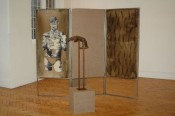Doubtless, strange events do permit themselves the occasional luxury of occurring, as the title of the exhibition curated by artist and musician Steven Claydon at Camden Arts Centre reminds us. But combining assorted twentieth-century and contemporary artworks around vague ideas of replication and the thingly, Claydon’s show proved disappointingly short on strangeness. Its clean fit with a dominant range of readily identifiable, easily marketable contemporary art trends rendered it generic and predictable, in outline if not always in detail. For the fashion-conscious art student, it could function as a midnoughties style sourcebook.
Most obviously, there’s the heavily mined motif of the artist as collector-connoisseur, or maybe flaneur-ragpicker, scavenging in the ruins of last-century visual culture for things that might be reinvested with novelty. Two of Claydon’s own pieces recycled the tactic at small scale: Steel-framed, burlap-covered, screen-like assemblages bearing paintings, cast sculptures, and readymades (such as office supplies), these objects’ status self-consciously hovered between sculpture and pedestal, home bookshelf and modernist museum or shop display unit. They bore close resemblance to Carol Bove’s A Setting for A. Pomodoro, 2005, a chic arrangement of concrete slabs, polished bronze frames, and driftwood chunks punctuated by a Pomodoro bronze sphere, itself borrowed from a private collection. Other works that rang changes on this theme were Mark Leckey’s videoed inventory of London’s public sculptures, The March of the Big White Barbarians, 2005; Keith Coventry’s suite of white monochromes-cum-hunting pictures, Endangered Species, 2005; Simon Martin’s video Carlton, 2006, a rostrum-camera study of a Memphis bookshelf voiced over with a critical commentary on its design; and that current must-have, a John Stezaker photocollage, Untitled Film Portrait Collage XXIII, 2007.
Claydon’s scavenging was lent an additional knowing twist by the use of what one might call avant-garde and modernist “trickle-down” rather than canonical sources. Thus, the machine aesthetic was figured via works by Eduardo Paolozzi; primitivism via the kitsch pastiche of Picabia’s Femme à L’idole (Woman with Idol), 1940-42, or pieces by Lynn Chadwick and Graham Sutherland; Op-art effects via an indifferent 1977 graph-paper drawing by Rachel Fenner. (Such later twentieth-century British spear-carriers were accorded a surprise appearance.) Today’s vogue for avant-garde performance costumes wasn’t directly flagged, but an Edward Burra watercolor of stylized commedia dell’arte figures (Design for a Drop Curtain, 1946) served as makeweight.
The show’s generic feel had a neutralizing effect on its exhibits, though some were genuinely interesting and others genuinely strange. Jim Shaw’s parody of a Masonic initiation, the video Initiation Ritual of the 360 Degree (from the Rite of the 360 Degree), 2002, was largely inaudible, and in this context Shaw’s irrationalism seemed not insidious but merely whimsical. The queerness of Claude Cahun’s photos seemed traduced into voguish pose. Neil Chapman’s creepy 2002 sound work Into the Plasma Pool, which edits snippets of broadcaster Alistair Cooke’s recordings to voice Jeff Goldblum’s script from David Cronenberg’s The Fly (1986), was all but hidden in the gallery lift.
Like much of the UK art scene’s present flirtation with modernism and avant-gardism, Claydon’s curating takes a dandyish, seigneurial attitude toward its sources. Commenting on a 2006 show of similarly premised contemporary works, Matthew Collings nailed the sensibility nicely. Missing an effective critical sense of modernism’s scale or scope, “the overriding feeling was of a theme for a young fogeys’ club night.” Back in the ’80s this was called “the postmodernism of reaction”: queerness is depoliticized, primitivism decoupled from postcolonial critique, pornography automatically construed as liberating, the idea of cultural ownership dismissed. But that useful phrase seems a less likely candidate for the new museum’s archive of historical fragments.
Steven Claydon: Strange Events Permit Themselves the Luxury of Occurring showed at Camden Arts Centre, London, UK between December 7 2007 – February 10 2008
Text ©Rachel Withers & Artforum International Magazine, Inc. 2008. Image © Steven Claydon, Camden Arts Centre: contact Camden Arts Centre for further details.
